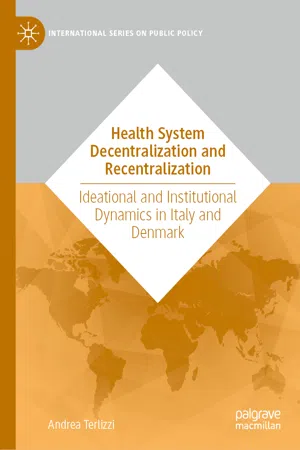1.1 Introduction
Decentralization is a key feature of contemporary governmental institutions . All over the world, the authority and responsibility over public policies are shared between different levels of government , to varying extents. Since the end of the Second World War, decentralization has been in fashion and has often been considered as a panacea and a normatively superior mode of allocation of authority. The belief that decentralization is a good thing has crossed ideological boundaries and it has been supported by both the left and the right. To put it in a nutshell, the main argument for advocates of decentralization is that the shift of authority towards lower levels brings government closer to citizens , enhancing accountability and responsiveness . In Europe, most countries transferred key dimensions of decision-making authority from the national to lower levels during the late 1960s and early 1970s. In many unitary countries, subnational governments were either newly created (e.g., in Italy ) or reinforced (e.g., in the Scandinavian countries). In federal countries (e.g., Germany) the role of subnational units vis-à-vis the national level has increased.
Health systems , as well as the welfare state in general, did not escape this decentralization wave. However, decentralization has been interpreted in different ways in different countries, and decision-makers across Europe have introduced decentralization strategies which have resulted in a variety of institutional arrangements. Moreover, in the last two decades, in several European countries the role of the central government in steering the decentralization of the health system has increased, though to a different extent. Some observers have referred to this trend as a new wave of recentralization (which, again, has not been limited to the health policy area) (see CEMR 2013; CLRA 2015, 2016; Saltman 2008; Saltman et al. 2012a, b). Such a new trend is visible in countries with a long-standing and strong tradition of decentralization , such as in Scandinavia, as well as in southern European countries, which since the end of dictatorships had undertaken a sound process of decentralization. The reasons for implementing elements of recentralization in the governance of health systems reflect common worries about the potential drawbacks of decentralization . Skeptics argue that decentralization can generate and trigger inequalities within countries. Other concerns regard the possible failure in meeting national objectives, with subnational governments pursuing policies that are inconsistent with national goals.
In a multi-level governance perspective, decentralization and recentralization reforms include three main levels: an institutional level (reorganization of powers and responsibilities across layers of government ), a territorial level (reorganization of territorial structures and boundaries), and a public management level (reorganization of subnational governments’ administrative and executive processes), with the latter being strictly related to the former two levels (OECD 2017). While in some countries reforms have resulted in changes in the territorial boundaries of subnational governments , in others there have been changes in the distribution of tasks between different levels of government , with or without reshaping territorial boundaries.
This book contributes to the literature on health systems , federalism and decentralization , and institutional change . It explores the dynamics of health system decentralization and recentralization , investigating why and how the territorial organization of health systems changes or remains stable over time. Research on the dynamics of federalism and decentralization has focused on several factors and driving forces, which mainly concern the role of ideas , interests and institutions . However, as far as decentralization in health care is concerned, most contributions are descriptive accounts of the institutional arrangements of decentralization , or treat decentralization as an independent variable, focusing on its impact on several dimensions of health systems . The literature witnesses few case studies explaining why and how continuity and change in health system decentralization occur.
The present book enters this relatively understudied area of health policy and systems research. Drawing from historical and discursive institutionalism , it points to the interplay between ideational and institutional explanatory factors. The analysis focuses on the tax-funded health systems of two European countries: Italy and Denmark . Besides being of the same type, the two systems present a decentralized architecture consisting of three levels: national , regional and municipal . Moreover, they have experienced changes, albeit of a different nature, in their territorial organization . Through the analysis of the reform trajectories in light of decentralization and recentralization processes, the book aims to analyze and reconstruct the mechanism through which distinct patterns of continuity and change in the territorial organization of the health systems have occurred over time.
The aim of this chapter is to introduce the overall topic of investigation. Section 1.2 reviews the literature on health system classification, and specifies which typology I refer to for case selection purposes. Section 1.3 provides conceptual and operational definitions of decentralization in health systems , defines change in health system decentralization, and therefore what recentralization entails. In orde...
